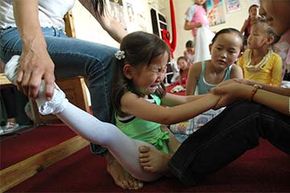What Is Contortion?
Contortionists are not acrobats. Well, a performer could be both a contortionist and an acrobat, but these are two different disciplines of circus art. Contortionism is a form of ultra-flexibility that allows a performer to bend in ways that seem completely unnatural and – often – highly uncomfortable. It's certainly helpful in acrobatics, a type of performance in which participants use ropes, high wires and other suspensions to accomplish feats of balance and aerial maneuvers. But while contortion focuses on the body's ability to bend and flex, acrobatics generally center on balancing and motor skills, like those necessary to walk a high wire or navigate a trapeze swing [sources: National Circus School Montreal, Aerialists.org].
Contortionists generally fall into one of three categories. Front benders, as the name suggests, are those who flex their spines forward in a number of strange and exotic ways. That includes wrapping the feet behind your head and walking around on your hands like some kind of human crab. In other words, a front bender has a unique ability to tell whether those pants do indeed make his or her butt look big [sources: National Circus School Montreal, Simply Circus].
Advertisement
Back benders, on the other hand, are generally considered the more artistic segment of the contortion community. They account for the "serious" portion of any contortion display, while front benders often fill the "funny man" role. One common back-bending exercise involves a contortionist lying on his or her chest with arms stretched above the head, slowly bending the legs backward until the toes touch the ground near the hands. Another move starts with the contortionist standing on his or her feet and slowly bending back until the hands touch the ground [sources: Simply Circus, Kanade].
Dislocation performers occupy a third, less prevalent category of contortionist. These are the Gumby-type folks who can slip certain bones in and out of their natural locations for fun [source: National Circus School Montreal].
